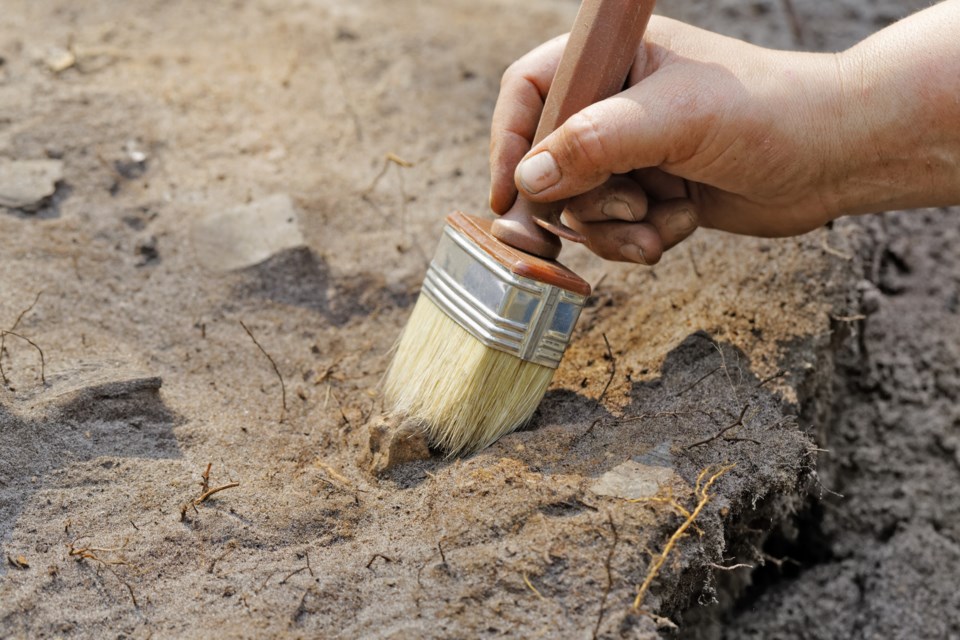Archeologists are back at work on a dig site near Parkside Drive.
The dig stopped in July 2023 after archeologists found the seasonal campsites made by Indigenous peoples and a Euro-Canadian homestead extended onto private property. The project was put on hold while the city expanded the dig and consulted with four First Nations groups.
Archeological digs are required by the City of Hamilton and the province before building roads or housing developments, and projects like the Waterdown Bypass seek input from First Nations communities.
But when it comes to what is found at these dig sites, returning items to the First Nations groups is difficult, and having them placed in a museum or repository isn't guaranteed.
Local historian, history teacher and member of the Ontario Heritage Trust Nathan Tidridge told FlamboroughToday, “A big question becomes, ‘What happens to those artifacts afterwards? And for the most part, they stay with those archeologists.”
Waterdown was ‘huge junction site’ for Indigenous nations
Unearthing Indigenous and early European settler artifacts is common in Flamborough, Tidridge said.
Waterdown was a “huge junction site” he said, for Indigenous nations like the Haudenosaunee, Neutral and Seneca people.
He said before Waterdown was established by European settlers, the area was “quite cosmopolitan, meaning all kinds of different nations were coming through here, settling here, existing here and also coming into conflict here.”
The homesteads and seasonal campsites found in the path of the new Waterdown Bypass are just one of many sites uncovered in the area.
Tidridge began a project called the Souharrisen Natural Area almost 10 years ago with his students at Waterdown District High School, after he became curious about the archeological digs happening near a new housing development just east of the village core.
“There isn't a building in Waterdown or a development that hasn't disturbed or uncovered Indigenous artifacts. The Souharrisen site, the natural area, was created to preserve some of those sites,” he said.
City of Hamilton manager of design and engineering Susan Jacob said "small artifact scatters" were found at the dig site for the Waterdown Bypass, and "reflect the use of the landscape as hunting and fishing grounds, as areas to forage and inhabit, and as agricultural fields."
The four communities interested in the dig at the Waterdown Bypass sites are the Mississaugas of the Credit First Nation, Six Nations of the Grand River, the Haudenosaunee Confederacy Chiefs Council represented by Haudenosaunee Development Institute, and Huron-Wendat Nation.
‘No one system that everybody is using’
But for the preservation of the artifacts themselves, there is more work to be done.
Heather George is the executive director of the Woodland Cultural Centre in Brantford. She said the Ontario Heritage Act requires archeologists to care for the items they find in certain ways, which means holding them privately or having them put in an approved repository.
But lack of provincial funding makes it difficult to submit items to those repositories, and Indigenous-led museums like the Woodland Cultural Centre or the First Nations communities the items come from, don’t have the facilities to store artifacts, even if they are interested in having them repatriated.
“It's a lot of space to store [the artifacts] as well,” George said, adding that right now Woodland is already focused on preserving language, caring for their current collections and educating.
“In terms of the actual material that comes out of the ground, that's up to the individual archaeologists to document in whatever way they're used to doing,” she said.
“There's no one system that everybody is using.”
George said there is a repository at McMaster University and another in London, Ont. at the Museum of Archeology.
Otherwise, caring for these items is a burden archeologists or their companies take on, she said, but can lead to poor record-keeping and missing catalogues.
“Older archaeological collections, especially, we may not even be aware of where they are,” she said.
Most artifacts will end up ‘in someone's garage’
The companies involved in the Waterdown dig, Archeaological Research Associates Ltd. and Historic Horizon Inc., could not be reached for comment in time for publication.
But artifacts aren’t just collected by archeologists.
“If you know the right farmers to talk to out on the Concessions, they have loads of artifacts,” Tidridge said.
George said that sometimes farmers can amass massive collections of Indigenous artifacts just by tilling their soil, and there isn’t a system in place to have these items documented and put in a repository.
“For somewhere like Woodland, we aren't accepting archaeological collections right now because we just don't have the capacity to go through 500 arrowheads and care for them,” she said.
Tidridge said this leaves a lot of artifacts in limbo, and open to being sold online on websites like Kijiji or eBay.
“For all the thousands of artifacts that have come out of the Waterdown area, most will end up in someone's garage,” he said.




